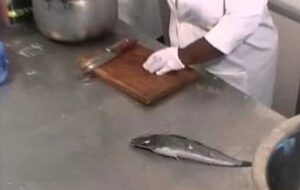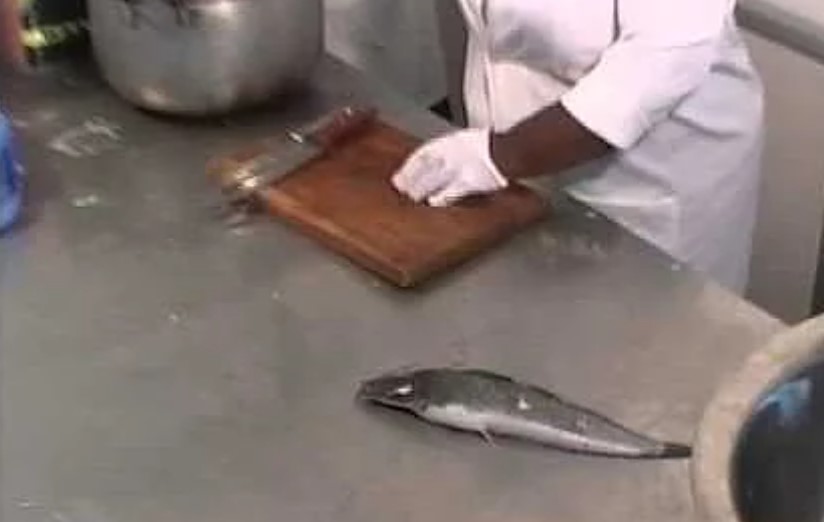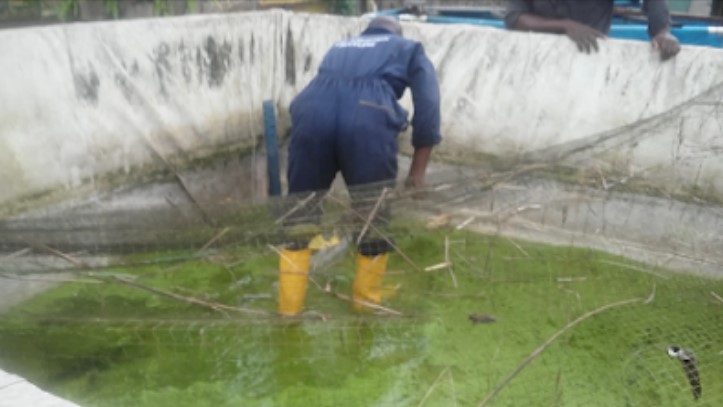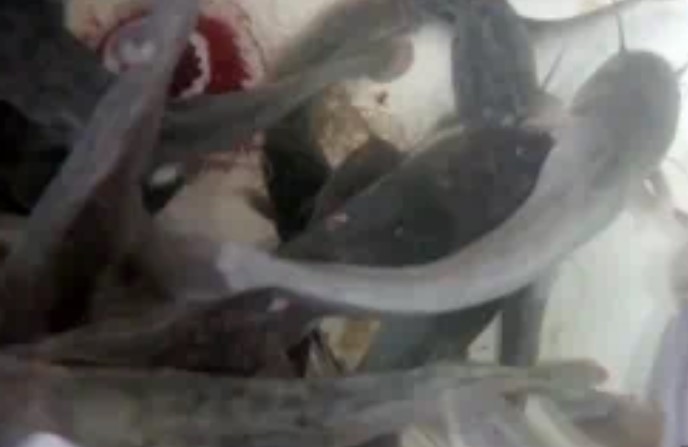Fish Processing and Handling

Fish Processing and Handling
Which is fresh? A product can be considered “fresh” when
(a) it has not been stored or preserved, and
(b) its original state remains “unimpaired,” meaning that it has not changed in any way. According to the second definition, fish that has been carefully frozen and thawed and is otherwise of high quality may well be considered fresh. For consideration of freshness, it is necessary to keep in mind both aspects of the definition.
Now that you have understood what fresh fish is, let’s go into our main topic of fish processing and handling.
Some guides for descriptions of fresh fish characteristics include the following:
Flesh:
Firm, elastic flesh not separating from bones, indicates that fish and flesh have been handled carefully.
Odour:
Fresh and mild. A fish just taken from the water has practically no fishy (ammoniacal) odour. The fish odour becomes more pronounced with time, but it should not be disagreeably strong when the fish are bought.
Eyes:
Bright, clear, and full. The eyes of fresh fish are bright and transparent; become cloudy and often turn pink in stale fish. The eyes often protrude in fresh fishy but become sunken with increasing staleness.
Gills:
Bright red. The colour gradually fades with age to light pink, then grey, and finally brownish or greenish.
Skin:
Shiny, with colour gradually not faded. Most fish are iridescent in appearance when taken from the water. Each species has its characteristic markings and colours which fade with increasing staleness.
- Flesh: fresh-cut in appearance, the colour should resemble that of freshly dressed fish. It should be firm and moist in texture, without traces of browning about the edge and without a dried-out look.
- Odor: Fresh and mild, not fishy, pungent, or ammoniacal
- Wrapping: If the fillets or steak are wrapped, the wrapping should be of moisture-vapor-proof material. There should be little or no air space between the fish and the wrapping.
Also See: 7 Things to Consider Before Starting a Fish Farm
Why Fish Spoil
Certain irreversible changes begin to take place immediately after the fish dies. Within some hours, the muscles gradually harden along the fish until it is quite stiff. The fish can remain rigid for several hours or a few days depending on various factors. Thereafter, the muscles then ‘soften’ or become pliable again. The stiffening is called rigour mortis and is brought about by enzymes in the muscle. It is important to filleting operations. Enzymes also cause complicated series of breakdowns of other tissue components, called autolysis (or self-digestion). Bacteria in addition, and un-gutted fish digestive juices, invade flesh to start the process of putrefaction. Lastly, fats are broken down by oxygen and can give rise to rancidity.
Autolytic Spoilage
The food supply ceases and the energy source depletes at death. The enzymes do not ‘die’; they can continue to operate but, since energy is required to build larger units, the function that the enzymes perform (post-mortem – after death) is to break (down) compounds into smaller units. This breakdown is called autolysis. Autolysis can affect flavour, texture, and sometimes, the aesthetics/appearance of flesh.
Flavour
The characteristic sweet, meaty flavour of fresh fish is (at least) partly due to a compound called inosinic acid; its breakdown through autolysis results in the loss of this flavour. Another compound, hypoxanthine, which is produced from the breakdown of inosinic acid, contributes to the bitter flavours of spoiled fish. Autolysis also contributes to bitter flavours by supplying compounds that the bacteria convert to unpleasant flavours (and odours).
Texture
The stiffening of fish (rigour mortis) and the subsequent softening (of fish) are caused by autolysis. Rigour is of great significance in fish processing, particularly in freezing operations for very fresh fish i.e. freezing at sea. In rigour, the fish can stiffen into distorted shapes and they can be difficult to load between freezer plates. Forcibly straightening the fish can lead to serious textural damage in the flesh when filleted. Fillets, cut before rigor and then frozen can contract during storage giving a tough rubbery texture.
Appearance
Yellowish-brown discolorations which are sometimes present in frozen flesh could be due to autolysis.
Bacterial spoilage
Bacteria present on the surface and in the guts multiply rapidly and invade the flesh when fish dies. In dead fish, bacteria can break down the muscle itself and also will ‘feed’ on the smaller units produced by autolytic action. The increase in the number of bacteria results in heavy slime on the skin and gills; an unpleasant ammoniacal, sour odour, and eventual softening of flesh. Frequently gut wall will burst.
The bacterial load present on the fish when caught will continue to multiply (even if thoroughly chilled in ice) until the fish is consumed. However, during handling, they are likely to pick up more bacteria, from washing in polluted water, careless gutting, dirty containers (boxes), etc. However careful you are in handling the fish, there will always be bacteria present but, with care, the members can be controlled.
Flesh from living fish is aseptic i.e. it is sterile. An aseptically removed flesh maintained at O° C for up to 6 weeks has no obvious organoleptic changes. Autolytic changes will, of course, be occurring during this period.
Table1. Yield from several species of fish (from considering a wide variety of data sources)
| Species | Dressed-fish (%) | Liver (%) | Viscera Less Liver (%) | Other trimmings(%) |
| Average species Flounder
Ling cod (the big head) Sockeye salmon |
65
67 54 73 |
2
1 1 2 |
8
7 8 6 |
25
25 37 19 |
Source: Stansby M. E. 1976. Industrial Fishery Technology. Robert E Krieger Publishing Co. Huntington, New York. 415pp.
Dressed fish average 78% flesh, 21% bone, and 6% skin.
Table 2. Proximate composition for edible portion fish in general
‘edible’ = skin and bone-free fillet.
| Statistics calculated(%) | Moisture (%) | Protein (%) | Oil (%) | Ash (%) |
| Average
Range Ratio high to low |
74.8
28-90 3.2 |
19
6.28 4.7 |
5
0.2 – 64 320 |
1.2
0.4-1.5 3.8 |
Oil content varies (even within the same species) with the Season of the year, geographical area, age, sex, and size of fish. The primary causes of variation are the degree of energy expenditure and food intake.
It is more meaningful to classify fish because of the variation V12:
Fig. 3. Varying oil content of some species of fish
| Category | Type | Oil Content (%) | Protein Content (%) | Prototype |
| A
B C D E |
Low oil – high protein
Medium oil – high protein High oil – low protein over Low oil – very high protein Low oil – low protein |
Under 5
5-15 over 15 5 <5 |
15-20
15-20 <15 >20 <15 |
Cod
Sockeye Siscowet lake Skipjack Halibut Clams, oysters |
Fig. 4. Types of composition for some important species
| Species | Primary category | Secondary Category |
| Anchovies
Bullhead and catfish Carp Clam Cod Crab Flounder Mackerel Menhaden Mullet Salmon (Atlantic, chum pink, silver) Salmon (king) Scallop Shrimp Tuna (albacore, bluefin) Tuna (skipjack, yellowfin) Whiting Yellow pike |
B
A A E A A A B B A B
B A A D D A A |
C
– B – – – – C C – A C
– D B – – – |
Oxidation of fish
In fatty fish, chemical changes involving oxygen from the air and fat of the fish may produce rancid odour and flavours. This problem is important when storing frozen fish for fairly long periods. Glazing before cold storage helps to alleviate the problem.
Fish Handling
Effect of fishing methods
The fishing method may affect freshness. A normally live fish e.g. tuna, or mackerel, may become excited and die in a frenzied state when seined. Similarly, certain types of gear e.g. gill nets may kill the fish after an exhausting struggle. Such exhausting activity before death results in the rapid development of rigor mortis followed by earlier signs of deterioration during icing. On the other hand, many salmon are caught by surface hook and line, brought (to the boat) quickly up, and dispatched quickly with a blow on the head. These don’t deteriorate fast. Halibut caught on a bottom hook and line usually comes to the surface easily and is quickly killed. Such ‘clean kills’ are significant in extending freshness and quality. Refrigeration brine immersion and electric shockers to stun or kill the fish immediately after harvest are used to control quality in modern aquaculture operations.
Physical damage:
Fishing gear and handling of the fish when the gear is brought aboard often contribute to bruising or tearing of the flesh during the transfer of fish in and out of the boat with spear and spearhead, gaff hooks, fish puns or forks are responsible for lots of unsightly and unsanitary holes in some fish before processing. Quick bacterial spoilage follows in these (pugh) marks. Rough weather on the trip back to port after fishing and excessive ice pressure in the bins accelerate the deterioration and increase the shrinkage of fish.
Condition:
fish are usually in a better condition if caught from tidal than still water (such fish are said to be doing more ‘exercise’).
Dressing:
Actively feeding fish when caught requires prompt dressing and icing or processing by or other methods to reduce the greater incidence of autolytic spoilage by digestive enzymes. Dressing involves the removal of gills, viscera, and scales (where present) immediately after catching and the removal of bones in some cases. The gut cavity should be washed with clean water (or clean sea water if at sea) before icing, 50ppm chlorine in seawater (in Atlantic trawlers) is more effective than plain sea water in rinsing blood and slime from the fish. The dressing is deemed impractical in some fisheries where fish value and size are small gutting and washing of fish here, however, has been (shown demonstrated to be very important.
Methods for preserving fish to reduce spoilage
Biological systems which operate bacterial and autolytic spoilage are only possible under certain optimum conditions. Altering the conditions can therefore provide ways of preventing or reducing spoilage. Since bacteria require water and are sensitive to heat, salt concentration, and pH, (there are) several approaches that can be used to prevent bacterial spoilage. Control of autolytic action (in the fishing industry) is by lowering the temperature. The enzymes could also be inactivated by other means e.g. irradiation with rays or by poisoning with chemicals.
Temperature control:
In cold-water fish enzymes and bacterial action are optimum at 5 – 10° C, and in warm-water fish, between 25-30° C. Lowering temperature prolongs storage life by reducing bacterial and enzyme activities.
Lowering temp.
Chilling: Holding fish above or just below freezing point i.e. reducing the temperature of fish from 25° C to 1-4° C in the tropics. Ice is ideal for chilling. Fish should be chilled as soon as possible. Ice is used for “short-term” storage though in some species it may be as long as one month.
It appears that generally
(1) Freshwater fish have a longer shelf life on ice than marine species e.g.
Tilapia (Freshwater fish) – 22-28 days
Mrigal carp (Freshwater fish) – 35 days
Nile perch (Freshwater fish) – 20 days
Snapper (Brazil) (tropical marine) – 11-16 days
Spanish mackerel (tropical marine) – 18 days
Bonga (tropical marine) – 20 days
(2) Tropical species keep longer than temperature or coldwater species on ice e.g.
Cod (temperate marine) – 12-15 days
Haddock (temperate marine) – 12-15days
Whitings (temperate marine) – 9-12 days
Trout (temperate freshwater) – 10 days
Channel catfish (temperate freshwater) – 12 days
(3) Non-fatty fish keep longer than fatty fish species
Freezing – Long-term storage i.e. for months, or years because
autolytic and bacterial action is almost arrested.
Read for more information
Eyo, J. E. and B. O Mgbenka. 1997. Methods of fish preservation in rural communities and
beyond. Pages 16 – 62. In H. M. G. Ezenwaji, N. M. Inyang and B. O. Mgbenka (eds.)
Proceedings of the Anambra State Ministry of Agriculture, Awka, and UNDP-sponsored
workshop on Women in Fish Handling, Processing, Preservation, Storage, and Marketing,
13 – 17 January 1997.


